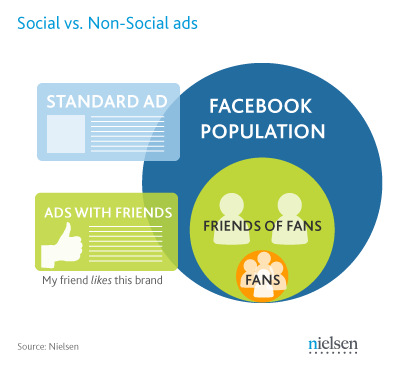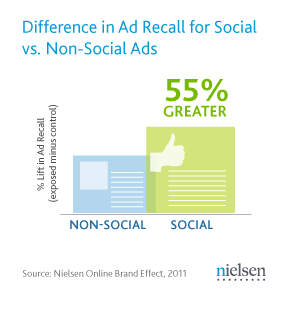As social networks have picked up a greater share of digital ad dollars, a key differentiator they emphasize to brand advertisers is the ability to harness the power of friend recommendations when it comes to sharing experiences and content.
Last week, Facebook introduced new advertising products that highlight friend connections on the site to make marketing more inherently social. Though social ads were previously available on Facebook, last week’s announcement signifies even greater emphasis on this unique form of advertising.
But do these types of social ads offer any advantages over their non-social counterparts? To answer this question, Nielsen analyzed* results from 79 Facebook campaigns over a period of six months to determine how well ads with social messages succeeded at breaking through to the audience. Social ads are those served to users who have friends that are fans of or have interacted with the advertised brand and prominently call the relationship out, while non-social ads are served to the remainder of the Facebook population.

While prior Nielsen research showed that online ads tend to be noticed and remembered overall, this analysis further demonstrates that social ads do provide an advantage. On average, social ads generate a 55% greater lift in ad recall than non-social ads, though individual cases may vary.

According to a 2011 Nielsen survey on consumers’ attitudes toward different types of advertising, 76 percent of U.S. Internet consumers said they most trusted recommendations from personal acquaintances, while 49 percent trusted consumer opinions posted online. Thus, it should come as no surprise that ads that reference a consumer’s friends prove more memorable than traditional ads with no social content.
Based on this analysis, more and more advertisers may consider leveraging ads with social content as a means to better utilize the power of the network of consumers engaged with their brands. This also serves as justification for marketers’ efforts to create more social connection points with their consumers, as their brands will be better positioned to reach a larger group of prospects.
*Methodology
This analysis included 79 English language Facebook campaigns measured by Nielsen Online Brand Effect in the second half of 2011. For studies in this time period Nielsen identified four types of respondents:
- Exposed users who saw social ads
- Control users who would have seen social ads (but did not due to a random holdout methodology)
- Exposed users who saw non-social ads
- Control users who would have seen non-social ads (but did not due to a random holdout methodology)
Nielsen then calculated lifts in ad recall for social and non-social ads based on the differences between exposed and control users. To be included in the analysis each study had to meet specific sample size requirements. Additionally, outliers (extreme high/low results) were removed.


